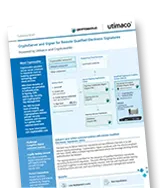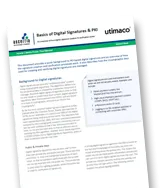- About Document Signing
- Solutions
- Related Products
- Resources
About Document Signing
Digital signatures make signing documents as valid as the pen and paper version - but with added digital security. Using document signing certificates, users can verify the sender’s identity and ensure documents remain unchanged.
- Verify authenticity – Confirm the sender’s identity.
- Prevent tampering – Ensure documents stay intact.
- Enhance security – Use cryptographic protection for trust.
With digital signatures, people can sign, protect, and verify documents effortlessly.
Enabling Highest Protection for Document Signing Certificates
Document signing certificates rely on a cryptographic key pair: a private key for signing and a public key for verification. To prevent forgery, these keys must be securely generated and protected.
A Hardware Security Module (HSM) handles this by creating, managing, and storing cryptographic keys in a tamper-resistant environment. Since the private key never leaves this secure space, it remains protected from exposure - ensuring signatures cannot be forged.
Solutions for Document Signing
Utimaco offers HSMs and digital signature solutions, including eIDAS-compliant versions for legally binding documents.
Utimaco’s key benefits for electronic document signing:
- Highest security – Certified to FIPS 140-2 Level 3 or 4 for highest level of physical security
- eIDAS compliance – Generate, validate, and archive qualified electronic signatures compliant to eIDAS
- As a service solution – Easily apply qualified electronic signatures with a dedicated, scalable solution as a service
Related Products
Resources

Join us for an insightful webinar and explore the top 5 applications of Hardware Security Modules (HSMs) as well as the essential role they play in securing digital environments.
The top 5 use cases of a Hardware Security Module (HSM) – incl. Demo
Join us for an insightful webinar and explore the top 5 applications of Hardware Security Modules (HSMs) as well as the essential role they play in securing digital environments.
Watch Now
The u.trust General Purpose HSM Se-Series combines superior performance with multi-tenancy. From entry-level to high-performance use cases, all models are future-proof with post quantum cryptography readiness and are FIPS 140-2 Level 3 certified.
u.trust General Purpose HSM Se-Series
The u.trust General Purpose HSM Se-Series combines superior performance with multi-tenancy. From entry-level to high-performance use cases, all models are future-proof with post quantum cryptography readiness and are FIPS 140-2 Level 3 certified.
Download
The CC eIDAS compliance version for CryptoServer General Purpose HSM supports Trust Service Providers (TSPs) in fulfilling policy and security requirements defined in various ETSI technical standards (ETSI EN 319 401, EN 319 411, EN 319 421).
CC eIDAS
The CC eIDAS compliance version for CryptoServer General Purpose HSM supports Trust Service Providers (TSPs) in fulfilling policy and security requirements defined in various ETSI technical standards (ETSI EN 319 401, EN 319 411, EN 319 421).
Download
The joint solution incorporates Utimaco and Cryptomathic products to provide a comprehensive and integrated remote QES signing solution. Unique additional security and compliance is achieved through the Signer firmware that runs inside the tamper-protected environment of the HSM.
Cryptomathic: CryptoServer and Signer for Remote Qualified Electronic Signatures
The joint solution incorporates Utimaco and Cryptomathic products to provide a comprehensive and integrated remote QES signing solution. Unique additional security and compliance is achieved through the Signer firmware that runs inside the tamper-protected environment of the HSM.
Download
This document provides a quick background to PKI-based digital signatures and an overview of how the signature creation and verification processes work. It also describes how the cryptographic keys used for creating and verifying digital signatures are managed.
Ascertia: Basics of Digital Signatures & PKI
This document provides a quick background to PKI-based digital signatures and an overview of how the signature creation and verification processes work. It also describes how the cryptographic keys used for creating and verifying digital signatures are managed.
Download









